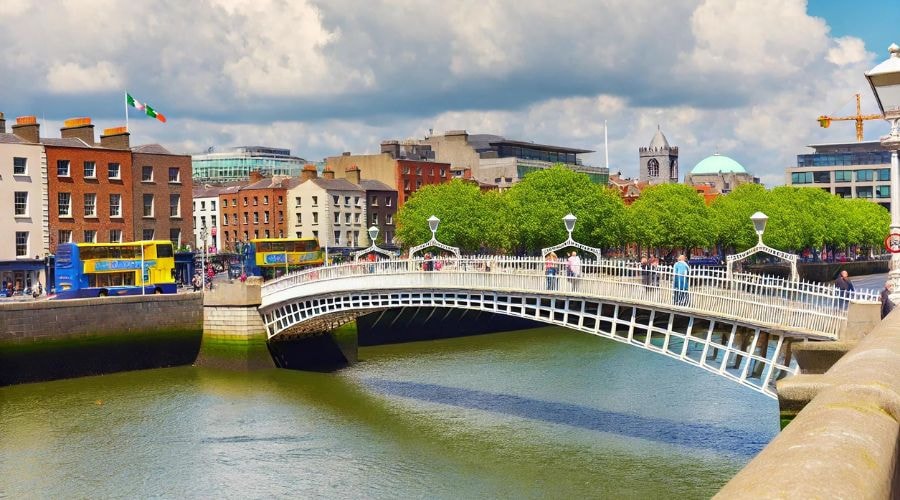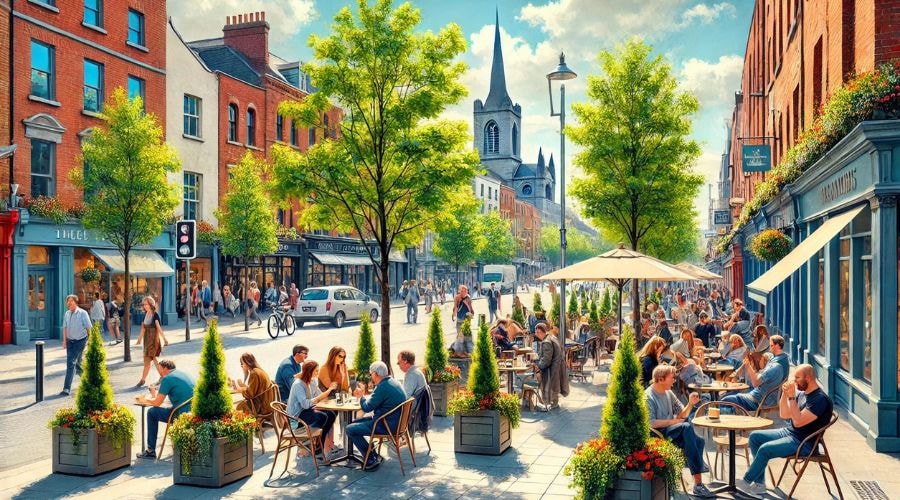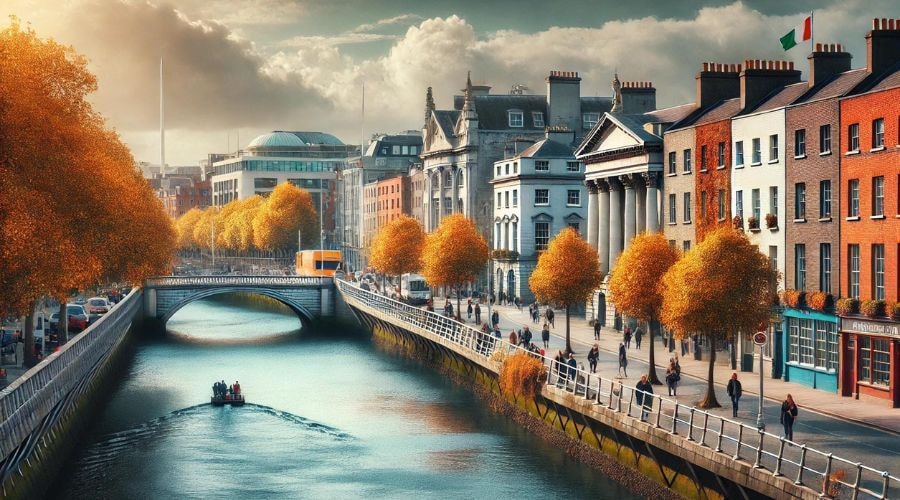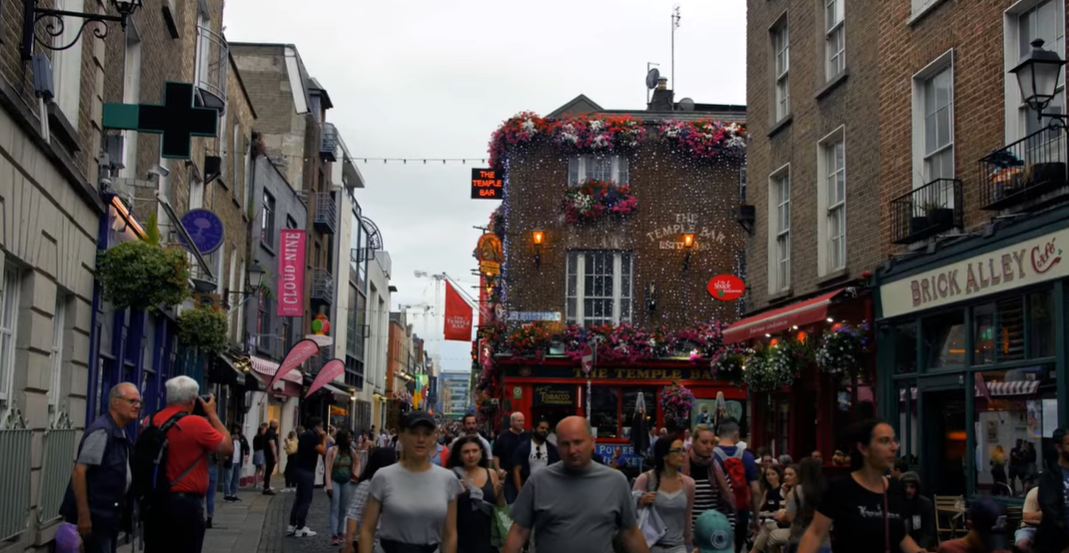The best time to visit Dublin is from May through September, when the weather is mild and the days are long. This period provides ample opportunity to explore Dublin's rich history and vibrant culture in comfort. The city's parks and gardens are in full bloom, and outdoor cafes are bustling with activity. For those seeking a quieter visit, the spring and autumn months offer fewer crowds and a chance to see the city's seasonal changes.

I had the pleasure of exploring Dublin during the pleasant month of June. The city was alive with the spirit of Bloomsday and other local festivals. Enjoying a leisurely stroll along the River Liffey and experiencing the lively atmosphere of Temple Bar are memories I cherish deeply. Dublin's unique charm is truly in its people and its streets, ready to be discovered regardless of the season.
| Season | Months | Weather | Highlights |
|---|---|---|---|
| Spring | March to May | Mild temperatures, occasional rain | Blooming flowers, St. Patrick's Day celebrations |
| Summer | June to August | Warmest weather, longer days | Festivals, outdoor activities, peak tourist season, Best Time To Visit Dublin |
| Autumn | September to November | Cooler temperatures, less crowded | Colorful foliage, cultural events |
| Winter | December to February | Cold, frequent rain, short days | Christmas markets, festive lights, off-peak season |
How Does the Weather Affect the Best Time to Visit Dublin?
The weather significantly influences the best time to visit Dublin. Dublin experiences a temperate maritime climate, making it relatively mild year-round. The ideal time to explore the city is during the summer months, from June to August, when temperatures average around 20°C (68°F) and rainfall is minimal. This period offers longer daylight hours without extreme temperatures, allowing more time for sightseeing and outdoor activities.
During summer, you can also experience a huge parade or two, and enjoy the ambiance of a traditional pub in the evenings. Conversely, winter sees shorter days and colder weather, with temperatures often dropping below 5°C (41°F), making outdoor exploration less comfortable. Despite this, it rarely snows in Dublin, so travel remains manageable. Spring and autumn provide a balance, with moderate temperatures and fewer tourists, ideal for those seeking a quieter visit. When you visit Ireland, especially the emerald isle of Dublin, you will find a city rich in history and culture.
Spring (March to May)

The weather significantly influences the best time to visit Dublin during the spring months of March to May. This period marks a gentle transition from the brisk, often chilly winter to a milder, more pleasant climate. Temperatures gradually increase, ranging from about 8°C in early March to around 15°C by late May. Rainfall is moderate but less frequent than in the fall and winter, allowing for more enjoyable outdoor activities and sightseeing.
Spring in Dublin showcases the city's natural beauty, with parks and gardens blooming and longer daylight hours. This makes it an ideal time for visitors to explore the historic sites, enjoy the vibrant street life, and participate in outdoor festivals. With fewer tourists compared to the peak summer season, spring offers a quieter, yet equally charming experience.
Summer (June to August)

During the summer months of June to August, Dublin offers its warmest and most pleasant weather. The city enjoys long daylight hours and mild temperatures averaging around 20°C (68°F), perfect for exploring its rich history and vibrant streets.
Rainfall is notably less frequent in summer, ensuring more consistent sunny days. This makes it a prime time for tourists to participate in outdoor cultural events, such as the famous Bloomsday Festival and the Taste of Dublin. Additionally, the pleasant weather facilitates leisurely strolls through Dublin’s picturesque parks and along the River Liffey.
Given the best weather these conditions, summer emerges as the optimal season for visitors seeking to experience the best of Dublin’s lively atmosphere and extensive cultural offerings.
Autumn (September to November)

The autumn months in Dublin offer a pleasant transition from the mild summer to the cooler winter. During this period, the city experiences a gradual drop in temperature, with average highs ranging from 16°C in September to 11°C in November. The weather is generally cool and comfortable, ideal for exploring outdoor attractions and enjoying the city’s parks.
-
Rainfall is moderate but consistent, making waterproof clothing a wise choice for visitors.
-
The natural scenery is particularly striking as the leaves change color, providing a beautiful backdrop for photography and sightseeing.
Visitors can take advantage of fewer tourists and shorter queues at popular sites. Dublin’s cultural calendar is full swing also vibrant during these months, featuring events like the Dublin Theatre Festival and Bram Stoker Festival. This combination of favorable weather, scenic beauty, and rich cultural offerings makes autumn a prime time to visit Dublin.
Winter (December to February)

The weather significantly influences the best time to visit cities in Dublin during the winter months of December to February. This period is marked by cold and damp conditions that can shape a visitor's experience. With temperatures hovering between 2°C and 8°C, Dublin's winter is chilly, though it often escapes the harsher freezes seen in other parts of Europe.
-
Dublin experiences cold and often wet weather, with temperatures typically ranging from 2°C to 8°C.
-
Shorter days and longer nights prevail, with the sun setting early in the afternoon.
Tourists should prepare for potential snow, though it is not very common. Indoor attractions like museums, historic pubs, and cozy cafes become particularly appealing. This season offers a unique charm, especially with festive Christmas markets and the lively celebration of New Year's Eve. However, those seeking outdoor activities may find the cold and damp weather less inviting.
When Are the Peak Tourist Seasons in Dublin?
The peak tourist seasons in Dublin are during the summer months of June to August and the festive period around Christmas and New Year. During these times, the city sees a significant influx of visitors drawn by the warmer weather, numerous festivals, and holiday events.
Understanding the best times to visit Dublin can enhance your travel experience, allowing you to fully engage with its lively festivals, picturesque landscapes, and friendly locals. Each season offers something special, attracting different crowds and activities that cater to a variety of interests and preferences.
Spring
Spring in Dublin is characterized by blossoming flowers and gradually warming temperatures, making it one of the best times for tourists to explore the city comfortably. From March to May, the crowds are still manageable, providing a quieter experience at popular attractions like Trinity College and St. Stephen’s Green. This season also sees the celebration of St. Patrick’s Day, a major event that draws many visitors in from around the globe.
Summer
As summer arrives, Dublin transforms into a bustling hub of activity. From June to mid August, the city hosts numerous festivals including the famous Bloomsday and the Dublin Pride Parade. Tourists and locals alike enjoy the long days and mild weather, perfect for outdoor concerts, picnics, and late-night pub crawls. The streets are vibrant, filled with performers and markets, making it the peak of tourist activity.
Autumn
Autumn brings a rich palette of colors to Dublin’s parks and streets, creating a picturesque setting for visitors. From September to November, the city celebrates its artistic side with events like the Dublin Theatre Festival and the Bram Stoker Festival. The cooler weather and decreasing crowds summer visitors make it an ideal time for those looking to enjoy a more laid-back visit with a cultural focus.
Winter
Winter in Dublin is a time of magical charm as the city gears up for the Christmas season. December is particularly festive with markets, light installations, and holiday concerts dominating the scene. While January and February are quieter, they offer the chance of experiencing Dublin’s cozy pubs and vibrant music scene without the usual tourist crowds.
When Are the Off-Peak Seasons in Dublin?
The off-peak seasons in Dublin are during the late fall and winter months, specifically from November to February, excluding the Christmas and New Year period. During these months, the city experiences fewer tourists, cooler weather, and often more affordable accommodation and flight options.
The off-peak seasons in Dublin are characterized by a noticeable drop in tourist activity, presenting a perfect opportunity for travelers to enjoy the city's offerings at a leisurely pace. Late autumn and early spring are particularly appealing as the city transitions through spectacular seasonal changes. During these times, visitors can take advantage of reduced rates in accommodations and more personal interactions with locals, enhancing the cultural immersion.
Autumn
From late October through early December, Dublin enters its off-peak season. The city's parks such as Phoenix Park and St. Stephen's Green are less crowded and painted with the gold and crimson of falling leaves. This period is ideal for those who enjoy crisp weather and the chance to experience local life without the peak season rush. Cultural events and live music sessions in pubs continue during these months, offering an authentic taste of Dublin's vibrant arts scene.
Spring
March to early May sees another decline in visitor numbers, making it a prime time to explore Dublin. The chill of winter begins to lift, replaced by milder temperatures and the first blooms of spring. Walking tours through the city become particularly pleasant, and with fewer tourists, access to popular sites like the Book of Kells and the Guinness Storehouse is easier. This season is also marked by the celebration of St. Patrick's Day, a festive time to enjoy the spirited culture of the Irish capital.
Best Time to Visit Dublin for Attending Festivals
The best times to visit Dublin for attending festivals are during St. Patrick's Day on March 17, the Dublin Theatre Festival from September to October, and the Christmas Markets and New Year Celebrations in December. Each period offers unique festivities that capture the vibrant culture of the city. St. Patrick’s Day showcases Dublin at its most lively, with parades and events celebrating Irish culture. The Dublin Theatre Festival, held in autumn, features world-class performances across various venues. Lastly, the holiday season transforms Dublin into a festive wonderland, ideal for experiencing traditional Christmas markets and vibrant New Year's festivities. These seasons provide tourists with a rich cultural experience and lively entertainment.
St. Patrick’s Day (March 17)
The best time to visit Dublin for attending festivals is around St. Patrick's Day on March 17. During this iconic celebration, the city bursts into life with a multitude of events that showcase the rich Irish culture and history. Streets are lined with colorful parades, live music echoes through the air, and pubs are filled with locals and tourists enjoying traditional Irish music and dance. This period also features a variety of cultural workshops, food fairs, and craft markets, providing a comprehensive experience of Ireland's heritage. The city's festive spirit is contagious, making it an unforgettable time for anyone interested in participating in one of Ireland’s most famous celebrations.
Dublin Theatre Festival (September-October)
The best time to visit Dublin for attending the Dublin Theatre Festival is during September to October. This period aligns perfectly with the festival's schedule, offering a vibrant array of theatrical performances across various venues in the city. During these months, theatre enthusiasts will find Dublin exceptionally lively, bustling with both national and international productions that showcase a wide range of dramatic arts.
Visiting in September and October also means experiencing Dublin in a mild autumn climate, which is generally pleasant and conducive for exploring the city's historic streets and cozy pubs between shows. Additionally, these months are packed with other cultural events and festivals, providing visitors with a rich and immersive cultural experience. This makes it an ideal time for those looking to absorb the artistic atmosphere and vibrant cultural life of Dublin.
Christmas Markets and New Year Celebrations
The best time to visit Dublin for attending festivals, such as the Christmas Markets and New Year celebrations, is during the winter months, especially December and early January. Dublin lights up with festive spirit during this period. The city hosts vibrant Christmas markets that feature artisan gifts, delicious food, and festive music. New Year's Eve in Dublin is a grand affair with fireworks, live performances, and street parties. This festive season offers a unique charm, making it an ideal time for visitors seeking a joyful and lively atmosphere.
Tips for Visiting Dublin
When planning your trip to Dublin in 2024, it's crucial to factor in both the local climate and the bustling cultural calendar to fully experience what the city has to offer. Dublin enjoys a temperate maritime climate, meaning mild temperatures and frequent rain throughout the year. This, coupled with the city's vibrant array of events and festivals, makes every season a unique opportunity to discover something new. Whether you're drawn by the allure of literary festivals, historic landmarks, or the lively pub scene, Dublin has something to entice every traveler.
Tips for Visiting Dublin:
-
Travel in late spring or early autumn: These periods offer the most pleasant weather, with fewer tourists and lower accommodation prices.
-
Book accommodations in advance: This is especially crucial during high-profile events like St. Patrick's Day, the Dublin Theatre Festival, and sporting fixtures, which can cause hotels to book up quickly.
-
Utilize public transportation: Dublin's extensive network of buses, trams, and trains makes it easy to navigate the city without a car. An Oyster travel card can be a cost-effective way to explore.
-
Experience live music in local pubs: No visit to Dublin is complete without enjoying the traditional music sessions that are a staple in many of the city’s pubs.
-
Explore beyond the city center: Take day trips to nearby attractions such as Howth, Malahide, and the Wicklow Mountains for a blend of history, nature, and breathtaking scenery.
Reflecting on your visit to Dublin, you'll appreciate the convenience of city transit and the genuine hospitality of its residents. Dublin offers diverse attractions year-round, making it a versatile destination for any traveler. While the city is compact and often walkable, always come prepared for the unpredictable Irish weather with appropriate clothing and a durable raincoat, ensuring a comfortable and enjoyable experience.
FAQs About Best Time To Visit Dublin
1. When is the best time to visit Dublin?
The best time to visit Dublin is during the months of May through September. Weather conditions are typically mild, and the city experiences its warmest weather and longest days, allowing for more sightseeing opportunities.
2. What are the benefits of visiting Dublin during the spring?
Visiting Dublin in the spring offers the advantage of blooming gardens and fewer tourists. The mild weather during April and May makes it ideal for outdoor activities and exploring the lush countryside.
3. How crowded is Dublin in the summer?
Dublin becomes quite crowded in the summer, especially in July and August. These months attract the biggest crowds and most tourists due to the warm weather and numerous festivals.
4. Are there any special events that coincide with the optimal visiting times?
Yes, visiting during the optimal times coincides with several special events in Dublin. The St. Patrick's Day Festival in March and the Bloomsday Festival in June are particularly noteworthy.
5. What should I expect weather-wise when visiting Dublin in the autumn?
Expect cooler temperatures and a higher chance of rain when visiting Dublin in the autumn. However, the changing leaves create a picturesque setting throughout the city.
